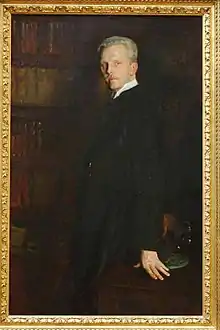Edward Robinson (curator)
Edward Robinson (November 1, 1858, Boston – April 18, 1931, New York City) was an American writer and authority on art.[1]
Edward Robinson (curator) | |
|---|---|
 Edward Robinson, John Singer Sargent, 1903 | |
| Born | November 1, 1858 |
| Died | 1931 |
| Nationality | American |
Biography
He graduated from Harvard in 1879, and spent the following five years in study, especially in Greece (15 months) and in Berlin (3 semesters), devoting his attention chiefly to archaeology.
From 1895 to 1902, he was curator of classical antiquities in the Boston Museum of Fine Arts, and beginning in 1902 was director of the museum for three years. He became assistant director of the Metropolitan Museum of Art in New York in 1906, and succeeded Sir Caspar Purdon Clarke in 1910, becoming the third director of "the Met", a position he held for 21 years.[2] He lectured on archaeology at Harvard in 1893-94 and in 1898-1902, and was secretary of the Art commission of Boston in 1890-98. He prepared catalogues and contributed many articles on art and archaeological subjects for magazines. He was a member of many learned societies.
References
- "Edward Robinson, Art Director Dies; ..." The New York Times. April 19, 1931.
- "Department History: The Practice of Objects Conservation in The Metropolitan Museum of Art, 1870–2011". Metropolitan Museum of Art.
References
- Reynolds, Francis J., ed. (1921). . Collier's New Encyclopedia. New York: P. F. Collier & Son Company.
- Rines, George Edwin, ed. (1920). . Encyclopedia Americana.
| Cultural offices | ||
|---|---|---|
| Preceded by Caspar Purdon Clarke |
Director of the Metropolitan Museum of Art 1910–1931 |
Succeeded by Herbert Eustis Winlock |
